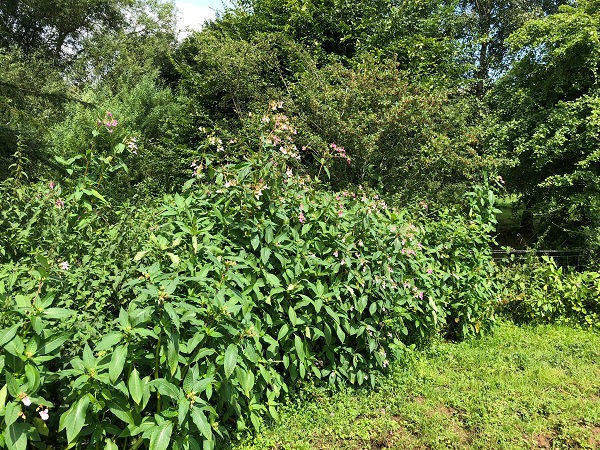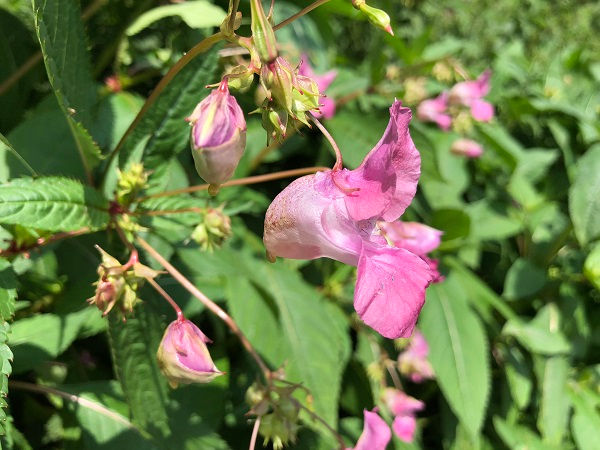Himalayan balsam - Impatiens glandulifera
- The Foraging Course Company
- Jan 24
- 3 min read
Updated: Feb 3

Edible plant - novice (NB: laws affect harvesting this plant) Season - spring to autumn Common names Himalayan balsam, Indian balsam, nuns, jumping jacks, bobby tops, copper tops, gnome’s hatstand, jewelweed, ornamental jewelweed, policeman’s helmet, kiss-me-on-the-mountain, Mr Noisy's exploding plant
Scientific name meaning: Impatiens originates from Latin and means impatient. This is in reference to the seed pods of Himilayan balsam readily bursting open. Glandulifera means to have have flowers with glands
Habitat  Himalayan balsam is a non-native invasive. It was introduced to Britain from India in 1839 and promoted as an alternative to the orchids grown by the wealthy. Its exploding seeds meant it quickly escaped gardens and it is now established as an invasive species across most of the world. It is commonly found along waterways and very damp areas, but can grow in drier areas, too. |
Overall structure  Himalayan balsam grows in tight stands and forms a mat of roots. Individual plants are tall and skinny, reaching 2m plus. |
Leaves  The teardrop-shaped leaves have a serrated edge. They can reach 15cm in length and appear in opposing pairs alternating on different sides of the stems. Sometime the leaves can appear in whorls. The leaf stem and mid-ribbed has a dark pink tinge. |
Stem  The stem can reach over 2m and can form side shooting branches. Its cross-section is hexagonal with a large central hollow. It is pale green in colour with pink/purple tinges to it. |
Flowers  The flowers can be pink or white and up to 5cm in height. Their shape is similar to old-fashioned police and fireman's helmets like helmets or Persian slippers. |
Seeds  The seed capsules broadens towards the tip given it an elongated cone shape. It has five sides, each of which is highly tense. When the seeds are ripe, the slightest disturbance causes each side to coil back at speed, dispersing seeds up to seven metres from the parent plant. |
Possible lookalikes  There are several other species of balsam that could be confused with Himalayan balsam, including the native but rare touch-me-not-balsam (Impatiens noli-tangere) and several introduced species, such as orange balsam (Impatiens capensis), pictured. However, all of these have either orange or yellow flowers. None are considered poisonous. |
Use as a food (NB: laws affect harvesting this plant). The seedings, young shoots, leaves, flowers are all edible with caution - see Hazards. They can be eaten raw or cooked. The seeds have a nutty flavour and give a nice texture and crunch to salads. Use in herbal medicine and medicine One of the ingredients in Bach's Rescue Remedy/SOS Formula
If you are suffering from any ailment or need medical advice, please see your General Practitioner.
Hazards Himalayan balsam contains high amounts of minerals so should not be consumed in great quantities. In addition, it contains calcium oxalate, which is harmful in volume in its raw state. However, thoroughly cooking breaks this down. People who suffer from arthritis, kidney or bladder stones gout, hyperacidity and rheumatism are advised against consuming Himalayan balsam.
Other uses The oil from the seeds has been used for cooking and in lamps Importance to other species Provides a food source for pollinators but means native plants are not pollinated as a result. It causes river erosion and out competes native plants so it has a huge negative impact on the ecosystem as a whole.
Always stay safe when foraging. You need to be 100% sure of your identification, 100% sure that your foraged item is edible, and 100% sure that you are not allergic to it (it is good practice to always try a small amount of any new food you are consuming). If in doubt, leave it out!









Comments